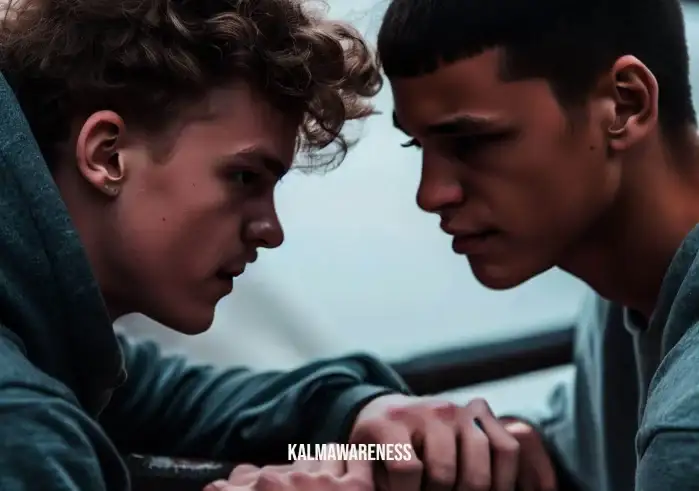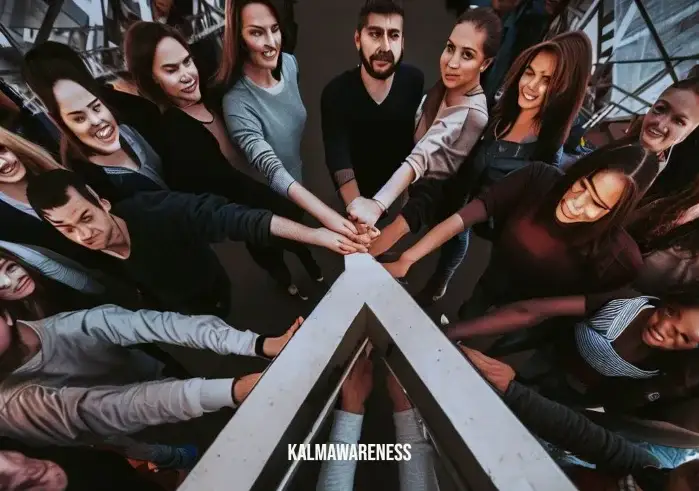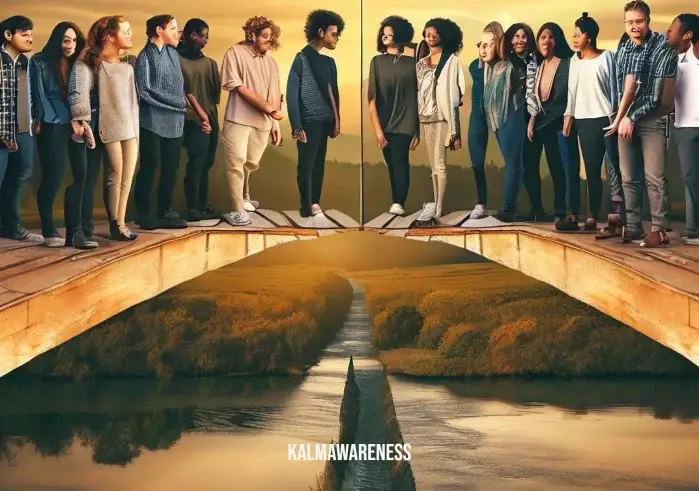Bridging the Hearts and Minds of Youth: A Holistic Approach to Nurturing the Next Generation
The world is teetering on the brink of monumental changes. As we endeavor to navigate through these complex times, the role of our young generation cannot be overstated. They hold the power to shape our future, but to do so effectively, they need guidance to connect their hearts and minds. They need to be emotionally intelligent, mentally resilient, and spiritually anchored. They need to experience a holistic upbringing that allows them to fully explore and express their inherent potential. This article discusses how we can bridge the hearts and minds of youth, fostering their holistic development and guiding them towards a purposeful life.
Youth: The Bedrock of Our Future
The essence of adolescence is a unique mix of potential and vulnerability. Youth hold within them the promise of the future, yet they also grapple with unique challenges that can make this critical period in life difficult. It is during these formative years that they begin to shape their identity, grapple with social pressures, and make significant decisions about their future. Thus, the importance of holistic guidance during these years cannot be overstated.
Youth today face unprecedented challenges, from the stress of academic achievement to the pressures of social media. As Vanessa Hill, a PBS neuroscience host, pointed out in her thought-provoking discussion, the adolescent brain is constantly evolving, and this evolution can be influenced by both positive and negative experiences.
In fact, research on the teenage brain has shown that during adolescence, the brain undergoes significant developmental changes. As a result, teenagers are uniquely susceptible to stress, anxiety, and other mental health issues.
“The teenage brain is not just an adult brain with fewer miles on it. It’s a paradoxical time of development. These are people with very sharp brains, but they’re not quite sure what to do with them.” – Research Neuroscientist Frances E. Jensen
The Power of Mindfulness in Youth Education
One effective approach to addressing these challenges and fostering holistic development is mindfulness. A growing body of research suggests that mindfulness can be a superpower for youth, providing them with essential tools to navigate their complex emotional landscapes and cultivate mental resilience.
The Mindful Project, an initiative aimed at integrating mindfulness into youth education, has highlighted the transformative power of this practice. Mindfulness has been shown to reduce stress, improve academic performance, and enhance emotional regulation, making it a key component of holistic youth education.
Mindfulness also plays a critical role in bridging the hearts and minds of youth, fostering a deep connection between their emotional and cognitive worlds. This balanced integration enables young people to grow into compassionate, mindful adults who can effectively navigate the complexities of the modern world.
A Journey Towards Self-Compassion and Kindness
In parallel with mindfulness, the cultivation of self-compassion and kindness is paramount in nurturing the hearts and minds of our youth. The Power of Self-Kindness cannot be overemphasized. This nurturing virtue serves as a potent antidote to the pervasive culture of self-criticism and perfectionism that can hinder young people’s emotional well-being.
Practices like self-compassion journal prompts can guide adolescents in developing self-kindness, fostering emotional resilience, and building a healthy self-esteem.
This is just the beginning of our exploration of bridging the hearts and minds of youth. Continue on to the next part of the article where we delve deeper into the world of mindfulness education, explore the role of the educator in this transformative journey, and introduce some key practices that can help nurture the hearts and minds of our youth. Let’s venture into this important discussion together.

The Educator’s Role in Bridging the Hearts and Minds of Youth
Building on our previous discussion on the power of mindfulness and self-compassion in youth development, it becomes evident that educators play an instrumental role in this transformative journey. Teaching is not merely about imparting academic knowledge; it involves guiding the youth towards holistic growth, nurturing their hearts and minds, and shaping their future.
Holistic Life Schools: A Paradigm Shift
Schools today are increasingly recognizing the importance of holistic development. There is a shift away from the traditional focus on academic achievement towards more comprehensive education that values emotional, mental, and spiritual growth. The emergence of holistic life schools exemplifies this paradigm shift.
Such schools integrate mindfulness and compassion-based practices into their curriculum, aiming to foster an environment that nurtures the overall well-being of their students. They utilize mindfulness-based programs and resources, like those provided by the Holistic Life Foundation, to equip students with the tools they need to navigate their emotional and cognitive landscapes.
The Mindful Educator: A Catalyst for Change
Teachers who embody mindfulness themselves can serve as potent catalysts for change in their students’ lives. Becoming a mindful educator involves cultivating personal mindfulness practices, being present, and creating an emotionally safe classroom environment.
Furthermore, several educator-focused programs like the Mindful Montessori initiative and the mindful parenting course offer valuable insights and training to help educators embody mindfulness in their teaching practices. Such programs emphasize the importance of fostering a deep connection between the teacher and the student, thereby bridging the hearts and minds of youth.
Key Practices for Nurturing Hearts and Minds
To implement this holistic approach in an educational setting, educators can utilize a range of mindfulness and self-compassion practices. Below are a few essential practices that can help in bridging the hearts and minds of youth:
- Meditation: Regular meditation can help students cultivate inner peace, manage stress, and enhance their focus. Guided journey meditations can be particularly useful for younger students, enabling them to explore their inner world in a safe and supportive setting.
- Mindful Movement: Physical activities like yoga and movement-based practices can help students connect with their bodies and emotions. The Yoga and Movement cluster offers a wealth of resources for integrating mindful movement into the school day.
- Compassionate Communication: Teaching students the skills of compassionate communication fosters empathy and understanding. Activities like Mindful Play can provide fun and engaging ways to develop these skills.
- Emotional Literacy: Helping students understand and express their emotions is vital for emotional well-being. Tools like the Mindfulness Journal for Kids can help students explore and express their emotions in a safe, supportive manner.
| Practice | Resource | Purpose |
|---|---|---|
| Meditation | Guided Journey Meditation | Cultivate inner peace, manage stress, enhance focus |
| Mindful Movement | Yoga and Movement Cluster | Connect with body and emotions |
| Compassionate Communication | Mindful Play | Foster empathy and understanding |
| Emotional Literacy | Mindfulness Journal for Kids | Understand and express emotions |
Having discussed the crucial role of educators in this journey, we will next explore the science behind mindfulness and the benefits it offers in the cognitive and emotional development of youth. I invite you to join us in the next part of the article, where we delve deeper into the neuroscience of mindfulness and the impact it has on the young minds and hearts we aim to bridge.

The Science Behind Bridging the Hearts and Minds of Youth
In this chapter, we delve into the fascinating world of neuroscience to uncover the science behind ‘bridging the hearts and minds of youth’. Our exploration not only solidifies the theoretical underpinnings of our subject but also strengthens the argument for incorporating mindfulness and emotional literacy in youth development.
Understanding the Teenage Brain
It’s no secret that adolescence is a time of remarkable change and growth. As Vanessa Hill from PBS explains, “There’s a lot going on in the teenage brain.” The transition from childhood to adulthood is accompanied by dramatic developments in the brain. According to neuroscience research on the teenage brain, the prefrontal cortex, which is responsible for decision-making and impulse control, is one of the last areas to mature.
This developmental stage is also marked by heightened emotional sensitivity, lending credibility to the importance of emotional literacy and mindfulness in helping teens navigate these challenging years. Notably, cultivating emotional intelligence during this period can significantly impact a person’s long-term emotional health, self-esteem, and relationships.
The Power of Mindfulness: A Neuroscientific Perspective
Neuroscience has shown that mindfulness practices can physically reshape the brain. According to research highlighted in the documentary BrainMind, mindfulness can enhance the density of grey matter in the prefrontal cortex, improving executive functions like focus, decision-making, and emotional regulation.
Furthermore, mindfulness practices can help ‘reset’ the affective circuits in our brain, thereby helping us manage our emotional responses better. As Prof. Michael Yellow Bird from the Mindfulness Project puts it, “Mindfulness is not just a mental or psychological thing. It’s biological, it’s neurological, it’s physical.”(Michael Yellow Bird Mindfulness)
As William James, a pioneer in psychology, famously said, “The greatest weapon against stress is our ability to choose one thought over another.” Mindfulness, in essence, helps youth to exercise this choice, offering a practical and powerful tool to navigate their tumultuous internal landscape.
Fostering Self-Esteem in Youth
Bridging the hearts and minds of youth also involves fostering healthy self-esteem. As Eleanor Roosevelt once said, “No one can make you feel inferior without your consent.” Teaching youth the power of self-kindness and giving them the tools to nurture positive self-regard is an essential component of this process.
To this end, mindfulness and self-compassion practices like self-esteem classes for youth can make a substantial difference. Such classes help young individuals develop a strong, positive sense of self, promoting mental health and resilience in the face of life’s challenges.
In the next chapter of our exploration, we will delve into practical strategies for incorporating mindfulness and emotional literacy into daily life, both at home and in the classroom. Together, we’ll explore how parents, educators, and even peers can play a role in ‘bridging the hearts and minds of youth’.

Practical Strategies: Bridging the Hearts and Minds of Youth
Having understood the importance of ‘bridging the hearts and minds of youth’, the challenge now is to practically implement this understanding. How can we help young individuals cultivate mindfulness and emotional literacy? What tools and strategies can we use? This chapter explores practical approaches to answer these pressing questions.
Mindful Learning: A New Approach to Education
“Education is not the filling of a pail, but the lighting of a fire.” – William Butler Yeats
Education plays a crucial role in shaping a young person’s mind and heart. Traditional education models focus primarily on intellectual development. However, the concept of mindful learning encourages a more holistic approach. It aims to nourish not only the intellect but also the emotional wellbeing of students, fostering a balance that is vital for overall development.
Schools around the world are now beginning to incorporate mindfulness into their curriculum. One such example is the Mindful Montessori Old Tappan, where mindfulness practices are integrated seamlessly into daily classroom activities.
| Mindfulness Practices in Classrooms | Expected Outcomes |
|---|---|
| Mindful breathing exercises | Improved focus |
| Guided meditation | Enhanced emotional regulation |
| Reflective journaling | Boosted self-awareness |
| Yoga and mindful movement | Increased body awareness and stress relief |
Encouraging Mindfulness at Home
“The greatest gifts you can give your children are the roots of responsibility and the wings of independence.” – Denis Waitley
Home is the first school, and parents are the first teachers. As such, incorporating mindfulness practices at home can significantly contribute to bridging the hearts and minds of youth.
Parents can engage their children in guided journey meditation or use resources like mindfulness books for tweens to nurture mindfulness. They can also enrol in a mindful parenting course to understand how to model and teach mindfulness to their children better.
The Role of Personal Growth
“The only person you are destined to become is the person you decide to be.” – Ralph Waldo Emerson
Personal growth plays a pivotal role in a young person’s life. With the right encouragement and resources, young people can take responsibility for their growth, develop resilience, and cultivate a growth mindset. Offering resources like a personal growth stipend can empower youth to explore and learn more about mindfulness and emotional literacy.
In the final chapter of our exploration, we will delve into the benefits and outcomes we can expect from ‘bridging the hearts and minds of youth’. We will also look at inspiring real-world examples where mindfulness and emotional literacy have made a significant positive impact on youth’s lives.

Outcomes and Inspirations: Bridging the Hearts and Minds of Youth
After traversing the multifaceted aspects of mindfulness, we arrive at the final chapter of our exploration into ‘bridging the hearts and minds of youth.’ Let’s delve into the outcomes that can be expected from integrating mindfulness and emotional literacy into the lives of young people and draw inspiration from real-life examples.
The Power of Mindfulness and Emotional Literacy
“In a gentle way, you can shake the world.” – Mahatma Gandhi
How can mindfulness and emotional literacy shape the future? It’s a question that lies at the core of our exploration. As we have discussed throughout our journey, these skills can significantly impact young individuals’ wellbeing, academic achievement, and ability to form positive relationships.
Practicing mindfulness improves cognitive capabilities, leading to better academic performance. It aids in stress management, enabling young minds to navigate the turbulent waters of adolescence with resilience and grace. On the other hand, emotional literacy allows them to form and maintain healthier relationships, contributing to a more fulfilling life.
The cultivation of mindfulness and emotional literacy has been recognized and encouraged globally. Schools and organizations are investing in mindfulness programs and resources. One such inspiring initiative is the Mindful Educator program, which aims to equip teachers with mindfulness tools to incorporate into their classrooms.
The Promising Impact: Real-world Examples
Real-world examples provide powerful testimony to the effectiveness of mindfulness and emotional literacy in transforming young lives. One such inspiring story is that of the Holistic Life Foundation, an organization that has been working to nurture mindfulness in inner-city youth. Their innovative programs have demonstrated the power of these skills in helping youth overcome challenges and realize their potential.
Another notable example is the Inward Bound Mindfulness Education program, which has helped many teenagers manage stress, develop emotional resilience, and cultivate compassion and empathy.
“The future belongs to those who believe in the beauty of their dreams.” – Eleanor Roosevelt
Every young person carries the potential to bring about positive change. By investing in their emotional wellbeing and mental resilience through mindfulness and emotional literacy, we’re not just building better individuals—we’re shaping a better future.
The Way Forward
Our journey of exploring ‘bridging the hearts and minds of youth’ comes to an end here, but the path to achieving this goal is an ongoing one. It requires a collective effort from educators, parents, policymakers, and society at large.
Thank you for accompanying us on this exploration. We hope it has inspired you to participate in this noble endeavor of nurturing mindful, emotionally literate youth, for they are the bearers of our collective future. Remember, it’s not about a sprint but a marathon that will lead us to a brighter, more compassionate world.

The Final Stretch: Bridging the Hearts and Minds of Youth – A Hopeful Horizon
As we reach the final stretch of our exploration, let’s take a moment to revisit our central theme: ‘bridging the hearts and minds of youth.’ While our journey is coming to an end, the path towards achieving this noble cause continues, enlightened with hope, brimming with possibilities, and warmed by the ever-burning flame of youthful potential.
Expanding Our Horizons
Let’s begin by visualizing our youth as vast, fertile lands of potential, awaiting cultivation. When we equip these young minds with mindfulness and emotional literacy, we sow seeds that are bound to bloom into a garden of empathy, resilience, and balance. This garden will nurture them, guide them in life’s journey, and serve as a beacon of hope in the face of adversity.
Teenage Wild is a perfect example of this vision coming to life. This initiative empowers teenagers to face life’s challenges with confidence and composure, and emerge stronger on the other side, proving that every adversity, every tribulation is a stepping stone towards personal growth.
“The best way to predict the future is to create it.” – Peter Drucker
Looking to the Future with Optimism
A future sculpted by mindful and emotionally literate youth is a future worth striving for. But what does this future look like?
- Empathy: In an era where divisive rhetoric is unfortunately prevalent, mindfulness and emotional literacy will be instrumental in fostering empathy and unity among diverse groups of people.
- Resilience: With the ever-increasing pressures of the modern world, cultivating resilience through these practices can help our youth navigate life’s ups and downs with grace and composure.
- Leadership: Mindfulness and emotional literacy equip our youth with the necessary skills to lead with compassion, understanding, and an inclusive outlook. These attributes are the cornerstones of effective leadership, as exemplified in the principles shared in the Mindful Leadership program.
“You are never too old to set another goal or to dream a new dream.” – C.S. Lewis
The Road Ahead
As we part ways at the end of this exploration, remember that this is not an end but a commencement of a new journey. The road to ‘bridging the hearts and minds of youth’ continues to unfurl before us, dotted with opportunities for growth, learning, and transformation.
We invite you to keep this exploration alive. Carry forward the essence of our journey, let it inform your interactions with young minds, and be a part of this global mission of fostering a mindful, emotionally literate generation.
Thank you for joining us in this exploration and for your commitment to this noble cause. We look forward to meeting you again in our future endeavors. Until then, we encourage you to continue diving deeper into the world of mindfulness and emotional literacy with our comprehensive resources and insightful articles. Remember, every step, no matter how small, contributes to bridging the hearts and minds of youth. Let’s continue to make strides towards that hopeful horizon.





